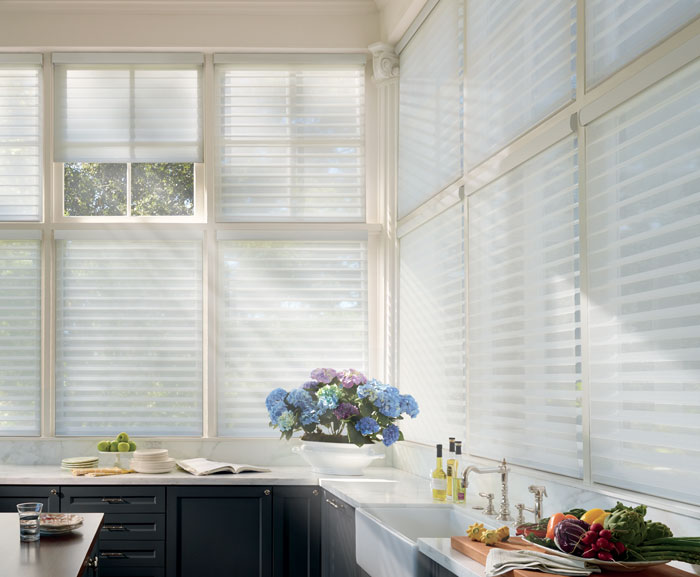See Superior Results With Custom Window Hardware vs. Off the Shelf
by Amy Meinecke
03 20, 2023 | Posted in Education | 0 comments

See Superior Results with Custom Window Hardware vs. Off the Shelf
Many people don’t realize the complexities of window hardware and how difficult it can be to install. The ease with which one can purchase curtain rods at department stores pales compared to the time and patience it takes to match decor and create the right look and feel for any room. Let’s take a look at your custom window hardware options.
Window Drapery Hardware Basics
You essentially have five components to drapery hardware.
- Rod
- Rings
- Brackets
- Finials
- Wands
You could chose a straight or French rod, which curves back into the wall. If you use the french rod, you won’t need finials, the decorative end pieces that complete the look and feel of your decor.
If you want to avoid grommet or rod-pocket drapery design, you should hang your draperies from rings.
And regardless of the type of rod, you’ll need brackets.
When you open and close draperies with a wand, you avoid tugging on the fabric. Over time pulling on the fabric risks damaging your draperies.
And this is just the beginning.
Difficult Window Types and Shapes
Windows come in all sizes and shapes, and they don’t always lend themselves to easy window dressing design! These exceptional cases often require custom window treatment hardware. Here’s a list of some of the more difficult challenges you could face and a professional tip to help you out.
- Wall of windows (leaving no wall space for rod brackets)
- Tip: Try a motorized ceiling track
- Bay Windows
- Tip: Try a curved or angled rod joined at the corners with hinges. This involves custom-cut hardware.
- Tall, imposing windows
- Tip: Most height issues are from windows on 2 story walls. Hiring a professional installer is highly recommended for this .
- Slanted Windows
- Tip: Choose medallion window shades.
- Shuttered Windows
- Tip: Try a pair of swing-arm rods.
- Recessed Windows
- Tip: Mount draperies just inside the nook, creating a pleasing sanctuary or haven.
- Curved Windows
- Tip: Try a custom curved rod.
- Arched Windows
- Tip: Shutters or honeycomb shades are an excellent option, but so is leaving it bare, with a light cafe curtain across the lower panes of the glass.
- Arched French doors
- Tip: Try curved rods
Although curved rods solve many difficult window treatment situations, they need to be measured and made to order from a custom hardware company. These companies don’t typically sell to the public, so you need to contact a Window Treatment company or Interior Designer.
Are you facing a challenging window design?
Call Window Works Studio for custom window hardware solutions!
Hanging Your Draperies
Before you begin installing your draperies, you’ll want to gather the right tools and resources to make it as easy as possible. Here are some items you should have handy.
- Drill
- Metal tape measure
- Level
- Pencil
- Step Ladder
- Wall Anchors
Read the installation instructions that came with your drapes or drapery rods, and check to see if you need additional resources before you get started.
4 Steps to Hanging Your Draperies
Hanging draperies can be intimidating for uninitiated. So, let’s take this step by step.
Step 1: Choose the Height
How high do you want your draperies? If you hang your rod directly above the window frame, you may end up with short, squat-looking windows.
Step 2: Install the Rod
Measure the space along the wall you intend to install the rod and mark off the bracket locations with a pencil. Use your level to check that your markings are even. Then use a drill to install the brackets and hang the rod on the brackets.
Caution! If you’re installing your drapery rods into drywall, be sure you’re mounting the brackets into the wall frame (studs). If you can’t find studs, use wall anchors. If you skip this step, you run the risk of loose brackets. Depending on the weight of your draperies, they could tear out of the wall.
Step 3: Hang Your Drapery
You can hang some draperies directly onto the rod, but not all. So, let’s outline different drapery types with step-by-step installation directions.
How to Install Rod Pocket Drapery
Rod pocket draperies are designed with a sleeve at the top of the drapery. Insert the drapery pole through the sleeve of each drapery panel before you place the rod on the brackets.
How to Install Pleated Drapery
The most common way to hang pleated draperies with pins and rings. Insert the drapery pins into the back of each pleat and insert into the curtain eyelets. Then hang the drapery on the rod.
How to Install Grommet Drapery
With grommet drapes, the rings are built into the fabric panels and reinforced with metal grommets. To maximize coverage, insert the rod into the first grommet with the excess fabric pointing inward toward the wall. Continue inserting the rod through the remaining grommets in an S-like weave.
Window Works Studio’s Tip for a Finished Look
Once you’ve hung your drapes, train them! This involves steaming them to remove the wrinkles and make the drapes moldable. After steaming, shape the fabric with hands to help it form waves in and out according to the waves the pleats create.
However, a word of caution: choose your heat settings carefully, so you don’t damage the material.
Outfitting your windows with custom window hardware and draperies may be a time-consuming, daunting task, but you’ll love the results!
Founder of the High Point Chapter of the WCAA. I was a Registered Nurse with a combined experience of 16 years, before obtaining a degree in clothing and textiles. I enjoy working with people and creating beautiful things that enhances my clients’ lives.


